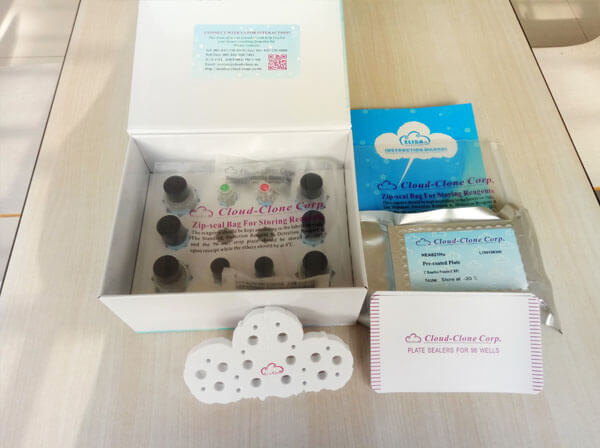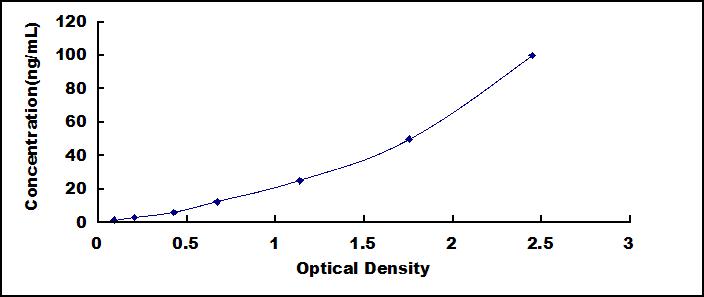High Sensitive ELISA Kit for Prolactin (PRL) 

LTH; Luteotropic Hormone
- UOM
- FOB US$ 582.00 US$ 832.00 US$ 3,744.00 US$ 7,072.00 US$ 58,240.00
- Quantity
Overview
Properties
- Product No.HEA846Po
- Organism SpeciesSus scrofa; Porcine (Pig) Same name, Different species.
- ApplicationsEnzyme-linked immunosorbent assay for Antigen Detection.
Research use only - DownloadInstruction Manual
- CategoryEndocrinologyReproductive scienceGenetic scienceHormone metabolism
Sign into your account
Share a new citation as an author
Upload your experimental result
Review

Contact us
Please fill in the blank.
Recovery
Matrices listed below were spiked with certain level of recombinant High Sensitive Prolactin (PRL) and the recovery rates were calculated by comparing the measured value to the expected amount of High Sensitive Prolactin (PRL) in samples.
| Matrix | Recovery range (%) | Average(%) |
| serum(n=5) | 78-94 | 86 |
| EDTA plasma(n=5) | 88-98 | 92 |
| heparin plasma(n=5) | 97-104 | 101 |
Precision
Intra-assay Precision (Precision within an assay): 3 samples with low, middle and high level High Sensitive Prolactin (PRL) were tested 20 times on one plate, respectively.
Inter-assay Precision (Precision between assays): 3 samples with low, middle and high level High Sensitive Prolactin (PRL) were tested on 3 different plates, 8 replicates in each plate.
CV(%) = SD/meanX100
Intra-Assay: CV<10%
Inter-Assay: CV<12%
Linearity
The linearity of the kit was assayed by testing samples spiked with appropriate concentration of High Sensitive Prolactin (PRL) and their serial dilutions. The results were demonstrated by the percentage of calculated concentration to the expected.
| Sample | 1:2 | 1:4 | 1:8 | 1:16 |
| serum(n=5) | 80-89% | 81-90% | 84-98% | 92-99% |
| EDTA plasma(n=5) | 89-102% | 94-104% | 78-101% | 88-96% |
| heparin plasma(n=5) | 80-88% | 84-98% | 88-101% | 79-104% |
Stability
The stability of kit is determined by the loss rate of activity. The loss rate of this kit is less than 5% within the expiration date under appropriate storage condition.
To minimize extra influence on the performance, operation procedures and lab conditions, especially room temperature, air humidity, incubator temperature should be strictly controlled. It is also strongly suggested that the whole assay is performed by the same operator from the beginning to the end.
Reagents and materials provided
| Reagents | Quantity | Reagents | Quantity |
| Pre-coated, ready to use 96-well strip plate | 1 | Plate sealer for 96 wells | 4 |
| Standard | 2 | Standard Diluent | 1×20mL |
| Detection Reagent A | 1×120µL | Assay Diluent A | 1×12mL |
| Detection Reagent B | 1×120µL | Assay Diluent B | 1×12mL |
| TMB Substrate | 1×9mL | Stop Solution | 1×6mL |
| Wash Buffer (30 × concentrate) | 1×20mL | Instruction manual | 1 |
Assay procedure summary
1. Prepare all reagents, samples and standards;
2. Add 100µL standard or sample to each well. Incubate 1 hours at 37°C;
3. Aspirate and add 100µL prepared Detection Reagent A. Incubate 1 hour at 37°C;
4. Aspirate and wash 3 times;
5. Add 100µL prepared Detection Reagent B. Incubate 30 minutes at 37°C;
6. Aspirate and wash 5 times;
7. Add 90µL Substrate Solution. Incubate 10-20 minutes at 37°C;
8. Add 50µL Stop Solution. Read at 450nm immediately.

Test principle
The test principle applied in this kit is Sandwich enzyme immunoassay. The microtiter plate provided in this kit has been pre-coated with an antibody specific to High Sensitive Prolactin (PRL). Standards or samples are then added to the appropriate microtiter plate wells with a biotin-conjugated antibody specific to High Sensitive Prolactin (PRL). Next, Avidin conjugated to Horseradish Peroxidase (HRP) is added to each microplate well and incubated. After TMB substrate solution is added, only those wells that contain High Sensitive Prolactin (PRL), biotin-conjugated antibody and enzyme-conjugated Avidin will exhibit a change in color. The enzyme-substrate reaction is terminated by the addition of sulphuric acid solution and the color change is measured spectrophotometrically at a wavelength of 450nm ± 10nm. The concentration of High Sensitive Prolactin (PRL) in the samples is then determined by comparing the O.D. of the samples to the standard curve.
Giveaways
Increment services
Citations
- In Vivo Evidence for Epidermal Growth Factor Receptor (EGFR)-mediated Release of Prolactin from the Pituitary GlandJcb: 39297
- TLR9 expression is associated with prognosis in patients with glioblastoma multiformeScienceDirect: S0967586811003572
- Determination of prolactin hormone in serum and urine using an electrochemical immunosensor based on poly(pyrrolepropionic acid)/carbon nanotubes hybrid modified electrodesSciencedirect:S0925400514000720
- Effect of extended photoperiod during winter on growth and onset of puberty in Murrah buffalo heifersPubmed:27051212
- Effect of thermal stress on physiological, hormonal and haematological parameters in Tharparkar and Karan Fries calvespublication:306322503
- Differentiation of human umbilical cord Wharton’s jelly-derived mesenchymal stem cells into endometrial cellspubmed:29096715
- The role of mesenchymal stem cells in chemotherapy-induced gonadotoxicityPubmed:30021657
- Impact of Triclosan on Female Reproduction through Reducing Thyroid Hormones to Suppress Hypothalamic Kisspeptin Neurons in MicePubmed:29403355
- The antipsychotics sulpiride induces fatty liver in rats via phosphorylation of insulin receptor substrate-1 at Serine 307-mediated adipose tissue insulin resistancePubmed:29551354
- The prolactin‐release inhibitor paeoniflorin suppresses proliferation and induces apoptosis in prolactinoma cells via the mitochondria‐dependent pathwayPubmed:29388711
- Metformin inhibits growth and prolactin secretion of pituitary prolactinoma cells and xenograftsPubmed: 30334324
- Hormonal and metabolic indicators before and after farrowing in sows affected with postpartum dysgalactia syndromePubmed: 30404636
- Expression of prolactin receptors in the duodenum, kidneys and skeletal system during physiological and sulpiride-induced hyperprolactinaemiaPubmed: 30143940
- Morphological and Biochemical Characteristics of Prostate Hyperplasia during Sulpiride TreatmentPubmed: 32152847
- Effect of heat stress during the early and late dry period on mammary gland development of Holstein dairy cattlePubmed: 32684470
- Pathophysiological Changes in Female Rats with Estrous Cycle Disorder Induced by Long-Term Heat StressPubmed: 32685488
- Prolactin affects the disappearance of ALV-J viremia in vivo and inhibits viral infection34391195
- Effects of a Nanoencapsulated Moringa Leaf Ethanolic Extract on the Physiology, Metabolism and Reproductive Performance of Rabbit Does during Summer34439574
- Yogurt Enriched with Inulin Ameliorated Reproductive Functions and Regulated Gut Microbiota in Dehydroepiandrosterone-Induced Polycystic Ovary Syndrome MicePubmed:35057459















